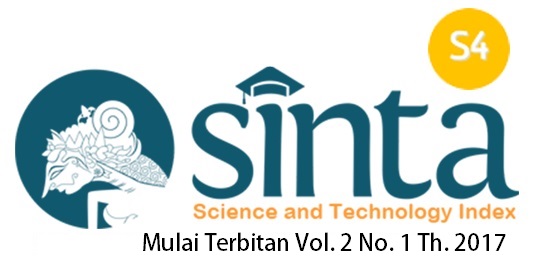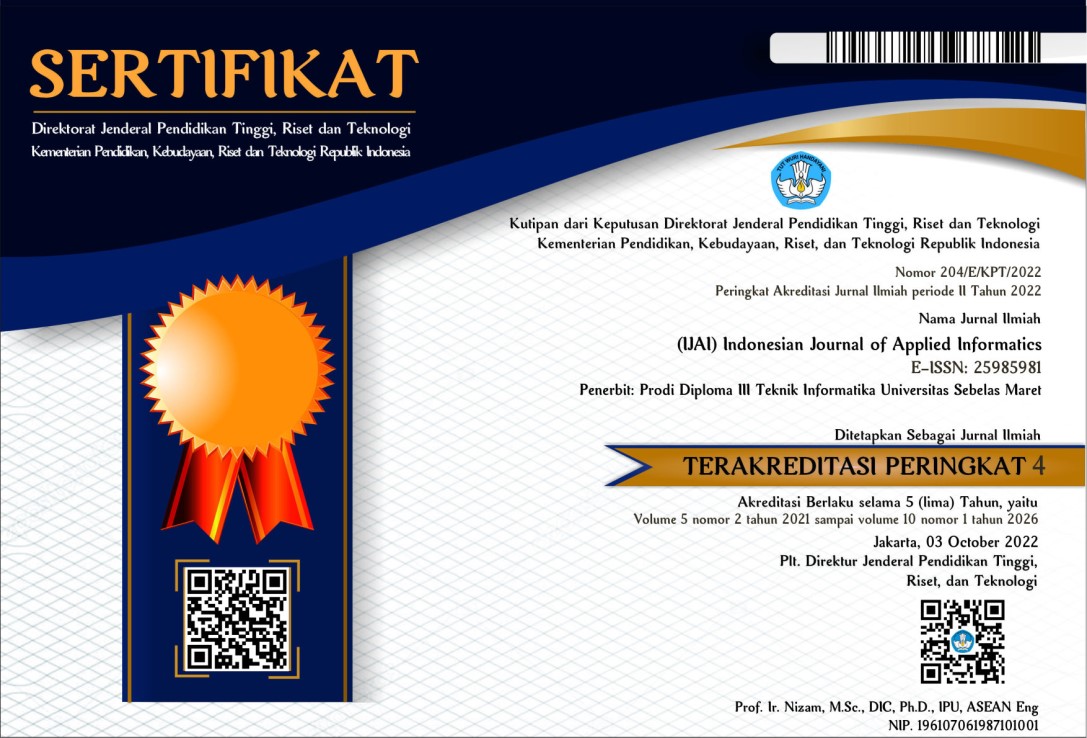Otomatisasi Pemberian Pakan Ikan Koi Berbasis IoT dengan ESP8266 dan Aplikasi Blynk
Abstract
Abstrak :
Ikan koi merupakan salah satu jenis ikan hias yang memerlukan perawatan intensif, khususnya dalam hal pemberian pakan secara rutin agar tumbuh dengan optimal. Kendala dalam menjaga jadwal pemberian pakan sering dialami oleh pemelihara, terutama yang memiliki mobilitas tinggi. Oleh karena itu, penelitian ini bertujuan merancang dan membangun prototype sistem otomatisasi pemberian pakan ikan koi berbasis Internet of Things (IoT) yang dapat dikontrol melalui aplikasi Blynk pada perangkat mobile. Sistem ini menggunakan mikrokontroler ESP8266 untuk mengatur mekanisme pengeluaran pakan yang dioperasikan dengan motor servo. Dengan sistem otomatis ini, pemberian pakan dapat dilakukan pada waktu yang telah ditentukan secara konsisten, sehingga kesehatan dan pertumbuhan ikan koi dapat terjaga. Prototype ini dirancang menggunakan metode waterfall yang mencakup tahap analisis sistem, perancangan, implementasi, dan pengujian. Hasil pengujian menunjukkan bahwa sistem ini dapat bekerja secara efektif sesuai jadwal yang diatur dari jarak jauh dengan tingkat keberhasilan sistem sebesar 95% dan keterlambatan koneksi pada jaringan rata-rata 1 detik.
===================================================
Abstract :
Koi fish are a type of ornamental fish that require intensive care, particularly in maintaining a regular feeding schedule to support optimal growth. Maintaining a consistent feeding schedule is often a challenge for keepers, especially those with high mobility. Therefore, this research aims to design and build a prototype of an automated koi fish feeding system based on the Internet of Things (IoT) that can be controlled through the Blynk application on mobile devices. The system uses the ESP8266 microcontroller to regulate the feed dispensing mechanism operated by a servo motor. With this automated system, feeding can be performed consistently at predetermined times, ensuring the health and growth of the koi fish. The prototype is designed using the waterfall method, which includes the stages of system analysis, design, implementation, and testing. The test results show that the system can operate effectively according to the remotely set schedule, with a system success rate of 95% and an average network connection delay of 1 second.
Full Text:
PDFReferences
[1] J. J. . Constana, H. S. . Utama, and S. Suraidi, “Perancangan dan Implementasi Sistem Otomatis Perangkat Penunjang Akuarium dan Sistem Monitoring pada Akuarium Ikan Mas Koki”, Jurnal Pendidikan Dan Konseling (JPDK), vol. 5, no. 1, pp. 4659–4668, 2023, https://journal.universitaspahlawan.ac.id/index.php/jpdk/article/view/11727/9005.
[2] A.L. . Fauzan, T. Budiarti, I. Effendi, I. Diatin, Y. Hadiroseyani, and N. N. . Dewi, “Analisis Produksi dan Distribusi Pembenihan Ikan Koi (Cyprinus Carpio) Berdasarkan Sebaran Kualitas Seleksi di Omah Koi Farm Indonesia”, Berita Biologi, vol. 23, no. 1, pp. 103–114, 2024, https://doi.org/10.55981/beritabiologi.2024.905.
[3] A. N. A. . Anshar, H. Harlina, and N. Nursyahran, “Efektivitas Ekstrak Daun Kelor (Moringa Oleifera) dalam Peningkatan Sistem Imun Pada Benih Ikan Mas (Cyprinus Carpio)”, Jurnal Akuakultur Nusantara (JANUS), vol. 1, no. 2, pp. 163–176, 2024, https://jurnal.fpik.umi.ac.id/index.php/JANUS/article/view/433/429.
[4] N. I. . Mas’ud and R. I. . Affandi, “Pemeliharaan Ikan Koi (Cyprinus Carpio) Pada Kolam Beton”, Jurnal Ganec Swara, vol. 18, no. 3, pp. 1288–1295, 2024, https://doi.org/10.35327/gara.v18i3.934.
[5] F. D. . Kurnia, N. Diniarti, and F. Azhar, “Pengaruh Penggunaan Bakteri Rhodobacter dengan Dosis Yang Berbeda Terhadap Kualitas Air Pemeliharaan Ikan Lele”, Jurnal Akuakultur Rawa Indonesia, vol. 10, no. 1, pp. 37–50, 2022, https://doi.org/10.36706/jari.v10i1.15596.
[6] C. F. . Hadi, V. A. . Sutrisno, and D. A. L. . Sari, “Prototype Pemberi Makan Ikan Otomatis Berbasis Arduino”, Jurnal Akuakultur Rawa Indonesia, vol. 10, no. 1, pp. 37–50, 2022, https://doi.org/10.59562/metrik.v20i3.48545.
[7] D. C. . Permana, R. Ferdiansyah, F. P. . Safira, Z. T. A. . Gumilang, A. J. Pangestu, and R. W. Abdul Rozak, “Otomasi Industri Sebuah Peluang Atau Ancaman”, Jurnal Pengabdian Masyarakat: Pemberdayaan, Inovasi Dan Perubahan, vol. 3, no. 3, pp. 139–145, 2023, https://www.researchgate.net/publication/371547860_OTOMASI_INDUSTRI_SEBUAH_PELUANG_ATAU_ANCAMAN.
[8] D. E.. Putri, “Perkembangan Teknologi Pakan Ikan Otomatis dalam Perikanan Modern”, Jurnal Ilmiah Telekomunikasi, Kendali Dan Elektronika Terapan, vol. 11, no. 2, pp. 160–172, 2023, https://doi.org/10.34010/telekontran.v11i2.11310.
[9] M. Marisal and M. Mulyadi, “Rancang Bangun Alat Pemberi Pakan Ikan Otomatis Berbasis Android”, El Sains : Jurnal Elektro, vol. 2, no. 1, pp. 51–54, 2020, https://doi.org/10.30996/elsains.v2i1.4015.
[10] Hayatunnufus and A. Debby, “Sistem Cerdas Pemberi Pakan Ikan Secara Otomatis”, Jurnal Teknologi dan Sistem Tertanam (JTST), vol. 1, no. 1, pp. 11–16, 2020, https://doi.org/10.33365/jtst.v1i1.799.
[11] Susilawati, A. Nugraha, A. S. . Buchori, S. Rahayu, F. Fathurohman, and O. Yudiyanto, “Design and implementation of automatic fish feeder (AFF) using microcontroller powered by solar cell: A Contribution to the fish farmers”, Mechanical Engineering for Society and Industry, vol. 3, no. 1, pp. 47–53, 2023, https://doi.org/10.31603/mesi.8276.
[12] A. Priyolistiyanto and S. Handayani, “Pengembangan Media Pembelajaran Pada Kelas Daring Materi Listrik Statis Bagi Siswa Kelas IX”, JIPETIK: Jurnal Ilmiah Penelitian Teknologi Informasi & Komputer, vol. 2, no. 1, pp. 76-80, 2021, https://doi.org/10.26877/jipetik.v2i1.9389.
[13] A. Putra, Pengantar NodeMCU ESP8266 dan Aplikasinya. Yogyakarta : Penerbit Elektronika Nusantara, 2022.
[14] A. Lestari and O. Candra, “Sistem Otomasi Pensortiran Barang berbasis Arduino Uno”, JTEV: Jurnal Teknik Elektro dan Vokasional, vol. 7, no. 1, pp. 27–36, 2021, https://doi.org/10.24036/jtev.v7i1.111504.
[15] F. Haykal, R. R. . Hariadi, and K. Ghozali, “Rancang Bangun Sistem Pemantauan dan Forecasting Konsumsi Energi Listrik Menggunakan Internet of Things dan Algoritma Seasonal Time Series”, Jurnal Ampere, vol. 11, no. 2, pp. 104–109, 2022, http://doi.org/10.12962/j23373539.v11i2.86571.
[16] S. Rahmat, A. Nurdiasari, and Z. Zaenurrohman, “The Implementation of NodeMCU ESP8266 for Smart Lamp in the Cilacap State Polytechnic Campus Area”, Journal of Telecommunication Network (Jurnal Jaringan Telekomunikasi), vol. 12, no. 2, pp. 95–99, 2022, https://doi.org/10.33795/jartel.v12i2.323.
[17] A. P. . Putra, “Sistem Keamanan Sepeda Motor Berbasis IoT (Internet of Things) dengan Smartphone Menggunakan NodeMCU”, JTT (Jurnal Teknologi Terpadu), vol. 9, no. 1, pp. 77–87, 2021, https://doi.org/10.32487/jtt.v9i1.1112.
[18] Y. Karmani, Y. S. . Belutowe, and E. R. . Nubatonis, “System Monitoring Tingkat Kekeruhan Air dan Pemberian Pakan Ikan pada Aquarium Berbasis IoT”, Jurnal Teknologi Informasi, vol. 6, no. 1, pp. 77–83, 2022, http://jurnal.una.ac.id/index.php/jurti/article/view/2598.
[19] A. E. . Novianto and L. Sulistyo, “Protoype Alat Pemberi Makan Ikan Aquarium Otomatis Berbasis Arduino Uno”, Jurnal ELKON: Elektro Kontrol, vol. 2, no. 1, pp. 28–34, 2021, https://doi.org/10.24176/elkon.v2i1.7391.
[20] S. P. Sari, J. M. Amelia, and G. I. . Setiabudi, “Pengaruh Perbedaan Suhu Terhadap Laju Pertumbuhan dan Kelulusan Hidup Benih Ikan Koi (Cyprinus carpio)”, Jurnal Perikanan, vol. 12, no. 3, pp. 346–354, 2022. http://doi.org/10.29303/jp.v12i3.328.
Refbacks
- There are currently no refbacks.






